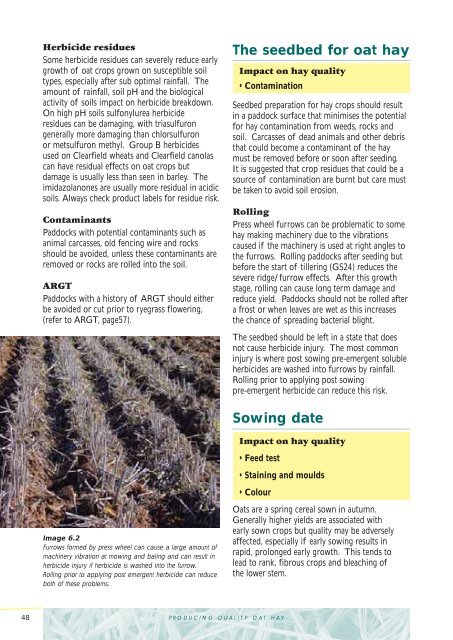You also want an ePaper? Increase the reach of your titles
YUMPU automatically turns print PDFs into web optimized ePapers that Google loves.
Herbicide residues<br />
Some herbicide residues can severely reduce early<br />
growth of oat crops grown on susceptible soil<br />
types, especially after sub optimal rainfall. The<br />
amount of rainfall, soil pH and the biological<br />
activity of soils impact on herbicide breakdown.<br />
On high pH soils sulfonylurea herbicide<br />
residues can be damaging, with triasulfuron<br />
generally more damaging than chlorsulfuron<br />
or metsulfuron methyl. Group B herbicides<br />
used on Clearfield wheats and Clearfield canolas<br />
can have residual effects on oat crops but<br />
damage is usually less than seen in barley. The<br />
imidazolanones are usually more residual in acidic<br />
soils. Always check product labels for residue risk.<br />
Contaminants<br />
Paddocks with potential contaminants such as<br />
animal carcasses, old fencing wire and rocks<br />
should be avoided, unless these contaminants are<br />
removed or rocks are rolled into the soil.<br />
ARGT<br />
Paddocks with a history of ARGT should either<br />
be avoided or cut prior to ryegrass flowering,<br />
(refer to ARGT, page57).<br />
Image 6.2<br />
Furrows formed by press wheel can cause a large amount of<br />
machinery vibration at mowing and baling and can result in<br />
herbicide injury if herbicide is washed into the furrow.<br />
Rolling prior to applying post emergent herbicide can reduce<br />
both of these problems.<br />
48 PRODUCING QUALITY OAT HAY<br />
The seedbed for oat hay<br />
Impact on hay quality<br />
• Contamination<br />
Seedbed preparation for hay crops should result<br />
in a paddock surface that minimises the potential<br />
for hay contamination from weeds, rocks and<br />
soil. Carcasses of dead animals and other debris<br />
that could become a contaminant of the hay<br />
must be removed before or soon after seeding.<br />
It is suggested that crop residues that could be a<br />
source of contamination are burnt but care must<br />
be taken to avoid soil erosion.<br />
Rolling<br />
Press wheel furrows can be problematic to some<br />
hay making machinery due to the vibrations<br />
caused if the machinery is used at right angles to<br />
the furrows. Rolling paddocks after seeding but<br />
before the start of tillering (GS24) reduces the<br />
severe ridge/furrow effects. After this growth<br />
stage, rolling can cause long term damage and<br />
reduce yield. Paddocks should not be rolled after<br />
a frost or when leaves are wet as this increases<br />
the chance of spreading bacterial blight.<br />
The seedbed should be left in a state that does<br />
not cause herbicide injury. The most common<br />
injury is where post sowing pre-emergent soluble<br />
herbicides are washed into furrows by rainfall.<br />
Rolling prior to applying post sowing<br />
pre-emergent herbicide can reduce this risk.<br />
Sowing date<br />
Impact on hay quality<br />
• Feed test<br />
• Staining and moulds<br />
• Colour<br />
<strong>Oat</strong>s are a spring cereal sown in autumn.<br />
Generally higher yields are associated with<br />
early sown crops but quality may be adversely<br />
affected, especially if early sowing results in<br />
rapid, prolonged early growth. This tends to<br />
lead to rank, fibrous crops and bleaching of<br />
the lower stem.

















